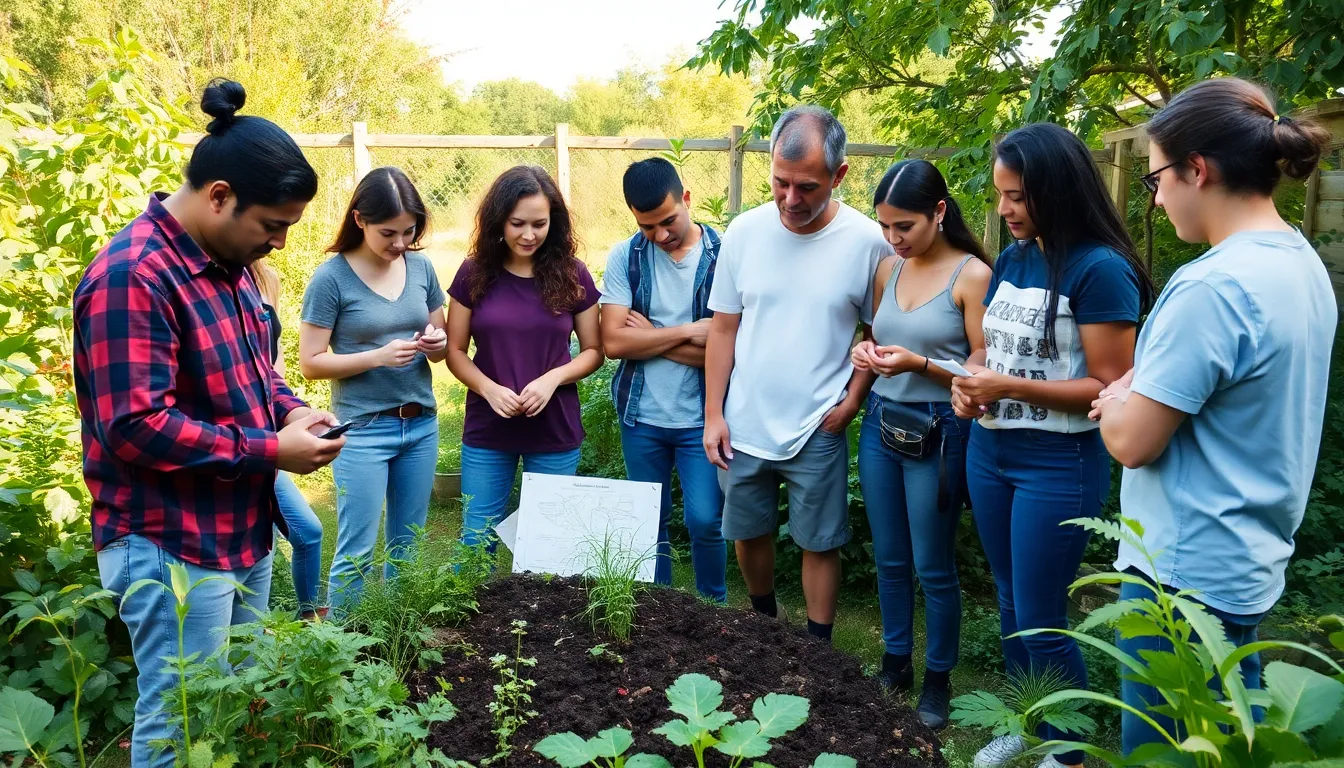Imagine a world where your garden not only feeds you but also takes care of itself. Enter permaculture design—a sustainable approach that’s like giving Mother Nature a high-five. This isn’t just about planting a few seeds and hoping for the best; it’s about creating a harmonious ecosystem where everything works together, just like a well-rehearsed band.
Table of Contents
ToggleOverview of Permaculture Design
Permaculture design represents an integrated approach to create sustainable living systems. It combines ecology, landscape design, and sustainable agriculture to build self-sustaining ecosystems. Practitioners apply specific principles to optimize resources and minimize waste.
Designing these systems requires observation and analysis of natural patterns. Elements like plants, animals, and soil work together to establish a harmonious environment. A permaculture garden often includes diverse crops, perennial plants, and edible landscaping features.
Strategies may involve zone planning, where areas are designated for different uses based on human activity. This planning enhances productivity and reduces labor by placing frequently accessed items closer to living spaces. Water management practices also play a vital role, utilizing strategies like rainwater harvesting and swales to maximize resource efficiency.
Soil health remains a priority in permaculture. Techniques such as composting, cover cropping, and mulching improve fertility and promote biodiversity. These practices foster a rich ecosystem that supports various organisms and enhances resilience against pests and diseases.
Collaborative efforts highlight the social aspects of permaculture. Community involvement in local food production strengthens connections among individuals and promotes ecological stewardship. Workshops and educational programs enrich understanding and empower people to implement permaculture practices in their own lives.
Overall, permaculture design emphasizes respect for nature and a commitment to sustainability. By focusing on the interconnectedness of all components in a system, it fosters a more resilient and productive approach to gardening and land use.
Principles of Permaculture Design

Permaculture design relies on a set of ethical guidelines and principles that inform sustainable practices. This approach focuses on creating systems that mirror natural ecosystems, emphasizing the importance of relationships among all elements.
Ethics of Permaculture
Ethics serve as the foundation for permaculture, guiding practitioners toward sustainable actions. Care for the Earth promotes environmental stewardship and the protection of ecosystems. Care for people emphasizes supporting communities and individual needs. Fair share encourages responsible resource distribution, ensuring that all benefit without depleting resources.
Design Principles
Design principles shape the implementation of permaculture systems. Observe and interact, encourages careful observation of natural patterns, informing design choices. Catch and store energy emphasizes the importance of maximizing energy resources, such as sunlight and wind. Use and value renewable resources suggests prioritizing materials that regenerate naturally. Finally, integrate rather than segregate fosters the idea of creating relationships between different system components, enhancing overall synergy and productivity.
Benefits of Permaculture Design
Permaculture design provides numerous advantages, supporting sustainable living and enhancing ecosystems.
Environmental Benefits
Permaculture design enhances biodiversity by integrating diverse plant species. This diversity creates habitats that support various wildlife. Soil health improves through practices like composting and mulching, which increase fertility. Reduced chemical use protects water quality and promotes resilience in ecosystems. Water conservation is vital, with techniques such as rainwater harvesting making efficient use of this critical resource. Establishing perennial plants minimizes soil disturbance, leading to decreased erosion. By sequestering carbon, permaculture gardens effectively contribute to mitigating climate change. Overall, these practices lead to healthier ecosystems and a more sustainable environment.
Economic Advantages
Cost savings arise from reduced input needs in permaculture systems. It emphasizes the importance of locally sourced food and resources, lowering transportation costs. Implementing permaculture often leads to decreased dependency on chemical fertilizers, driving down maintenance expenses. Communities benefit from the creation of local food networks, enhancing food security and resilience. Training and workshops foster skills that promote self-sufficiency, encouraging individuals to grow their own foods. Engaging in permaculture also cultivates community connections, supporting local economies through shared resources and knowledge. Overall, the economic aspects of permaculture design promote sustainability and collaboration, leading to thriving communities.
Implementing Permaculture Design
Implementing permaculture design involves a systematic approach to creating sustainable living environments. Practitioners follow specific strategies to achieve an efficient ecosystem.
Steps for Designing a Permaculture Site
- Observe the site thoroughly. Natural patterns, existing flora and fauna, and topography provide crucial insights.
- Assess resources, including sunlight, water flow, and soil quality. Each element contributes to a productive design.
- Plan zones based on human activity frequency. More intensive use occurs near the home, while less frequent areas can support wilderness.
- Select appropriate plants that complement each other. Diversity enhances resilience and yields.
- Integrate systems, ensuring all components support one another. This includes pairing plants with animals for mutual benefit.
Tools and Resources for Permaculture Design
Utilizing the right tools simplifies the implementation of permaculture principles. Soil testing kits identify nutrient levels and pH balance.
Diverse planting guides offer insight into local ecosystems. Online platforms provide virtual courses and workshops, enhancing community knowledge.
Design software enables virtual mapping of the site. Platforms like SketchUp and Permaculture Design Tools help visualize and strategize layouts effectively.
Reference books on permaculture principles provide in-depth understanding. Authors like Bill Mollison and David Holmgren offer valuable insights into sustainable practices.
Challenges in Permaculture Design
Permaculture design faces various challenges that can hinder successful implementation. Common obstacles include limited resources, insufficient knowledge, climate variability, and zoning regulations. Practitioners often face difficulty in accessing quality materials or funding, which can impede project initiation. Knowledge gaps regarding specific techniques or principles may arise, limiting the effectiveness of designs. Additionally, unpredictable weather patterns create uncertainty in crop production and resource management. Local zoning laws may restrict the integration of desired elements, further complicating efforts.
Common Obstacles
Practitioners often encounter limited funding opportunities. Compounded with a lack of local knowledge regarding permaculture practices, this creates significant barriers. Climatic factors like drought or excessive rainfall hinder planning and implementation. Complex regulations can restrict desired transformations in land use, diminishing adaptability. The physical landscape may present issues, such as poor soil quality or inadequate water supply, impacting overall productivity. Community resistance to new methods creates additional challenges for advocates attempting to introduce sustainable practices.
Strategies for Overcoming Challenges
Enhancing knowledge through workshops and community involvement can bridge educational gaps. Engaging local experts provides insights into effective techniques and builds confidence. Implementing small-scale projects allows for manageable experimentation, gradually expanding successful methods. Networking with experienced practitioners offers support and shared resources. Advocating for policy changes helps address local regulations, fostering a more accommodating environment for permaculture practices. Utilizing drought-resistant plants ensures adaptability to climatic variability, promoting resilience and long-term sustainability in design efforts.
Embracing permaculture design offers a pathway to sustainable living that harmonizes human needs with nature’s rhythms. By prioritizing ecological balance and community involvement, it cultivates resilience and fosters a deeper connection to the environment. The principles of permaculture not only enhance biodiversity and soil health but also empower individuals to take charge of their food systems.
As challenges arise, the adaptability of permaculture practices ensures that practitioners can find innovative solutions. Whether through workshops or community initiatives, the journey toward a self-sustaining ecosystem is one of continuous learning and collaboration. Ultimately, permaculture design stands as a beacon of hope for a more sustainable and equitable future.






